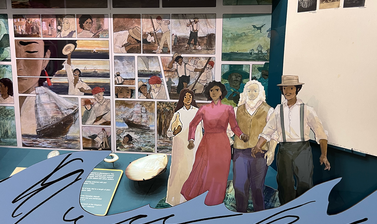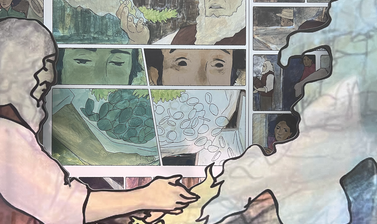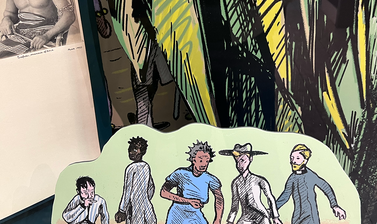Revisiting Robert Louis Stevenson in the Pacific
In this Archive Case display, artists Simon Grennan and Solomon Enos re-examine the work of nineteenth century author Robert Louis Stevenson through dynamic graphic storytelling. Stevenson travelled to several Pacific islands before settling in Sāmoa in 1890. Referencing this time in Sāmoa, as well as Hawai’i and Europe, related items are brought together from the Museum's Pacific collections and displayed alongside historical publications of Stevenson's Pacific stories, set within new graphic remediations of these stories as comics by British and Hawaiian artists. The illustration-led display explores the journey of ideas across media (remediation) in the nineteenth and twenty-first centuries, Robert Louis Stevenson’s fascination with ‘the foreign', and post-colonialism in the Pacific, including new poetry focused on Hawaiian, Samoan and European post-colonialism.
The display at the Pitt Rivers Museum celebrates work that is part of a wider research project 'Remediating Stevenson', led by a UK research team (Michelle Keown, Shari Sabeti and Alice Kelly, Edinburgh University; and Simon Grennan, Chester University), in partnership with the National University of Sāmoa. The project explores Robert Louise Stevenson's Pacific fiction, travels, and friendship with Indigenous Pacific communities. The Remediating Robert Louis Stevenson project is producing the first ever multilingual graphic adaptation of the three stories from Robert Louis Stevenson's Island Nights' Entertainments (1893). The project is also commissioning new poetry by indigenous Pacific authors, and developing a set of accompanying teaching resources for use in Sāmoa, Hawai’i and Scotland through participatory arts workshops and film-making.
'Shadow Play'
Simon Grennan
One half of the exhibit feature drawings from British Artist Simon Grennan's graphic adaptation of R. L. Stevenson's adventure story 'The Beach of Falesá' (1892) which Grennan has renamed 'Shadow Play'. Also on display are photographs from the Museum's collections. These bear witness to Stevenson's close friendship and alliances with Sāmoans. Written while Stevenson was living in Sāmoa (where he died in 1894), the story features a British trader and his Indigenous wife who defeat a corrupt Englishman attempting to monopolise the island's copra trade.
Grennan's research included workshops with teachers and students who will use the completed visual narrative as a learning resource. Victorian magazine pages used in workshops and a student collage are also included in the display. Excerpts from poems by project authors Selina Tusitala Marsh and Caroline Sinavaiana-Gabbard, inspired by Stevenson's fiction also feature.
'The Isle of Voices'
Solomon Enos
One half of the exhibit features drawings from Hawaiian Artist Solomon Enos' graphic adaptation of Stevenson's story 'The Isle of Voices' (1893). This story features a Hawaiian woman who rescues her partner from exile in the Tuamotu archipelago (in French Polynesia). The island's natural resources are exploited by sorcerers who transform local shells into coins (such as the Hawaiian silver dollar included in the display, alongside a Tuamotuan fish hook and shell necklace from the Museum collections). Also displayed are late nineteenth-century photographs of Tahitians and Hawaiians, including Kamehameha V (King of Hawai'i from 1863–1872), who is mentioned in 'The Isle of Voices'.
The silent film loop included in the display features locations in Hawai’i, Sāmoa, and the Tuamotu archipelago visited by the project team.










